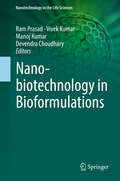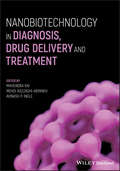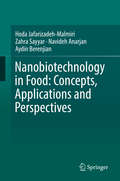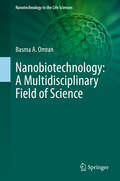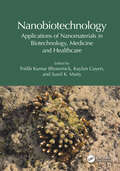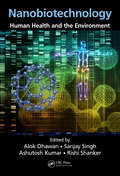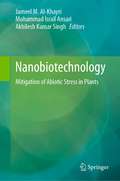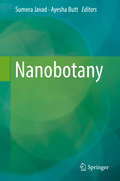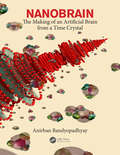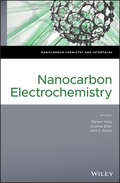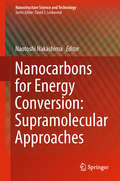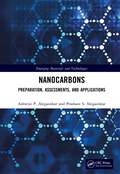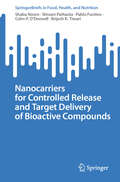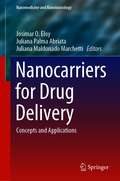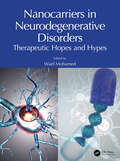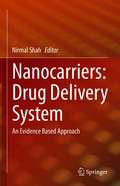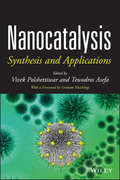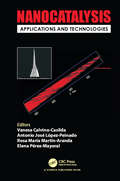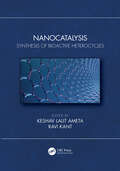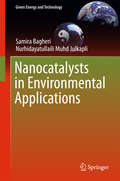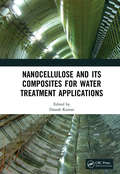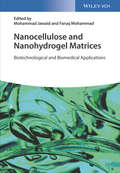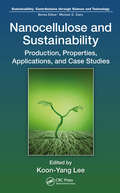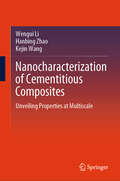- Table View
- List View
Nanobiotechnology in Bioformulations (Nanotechnology in the Life Sciences)
by Manoj Kumar Ram Prasad Vivek Kumar Devendra ChoudharyWith the recent shift of chemical fertilizers and pesticides to organic agriculture, the employment of microbes that perform significant beneficial functions for plants has been highlighted. This book presents timely discussion and coverage on the use of microbial formulations, which range from powdered or charcoal-based to solution and secondary metabolite-based bioformulations. Bioformulation development of biofertilizers and biopesticides coupled with the advantages of nanobiotechnology propose significant applications in the agricultural section including nanobiosensors, nanoherbicides, and smart transport systems for the regulated release of agrochemical. Moreover, the formulation of secondary metabolites against individual phytopathogens could be used irrespective of geographical positions with higher disease incidences. The prospective advantages and uses of nanobiotechnology generate tremendous interest, as it could augment production of agricultural produce while being cost-effective both energetically and economically. This bioformulation approach is incomparable to existing technology, as the bioformulation would explicitly target the particular pathogen without harming the natural microbiome of the ecosystem.Nanobiotechnology in Bioformulations covers the constraints associated with large-scale development and commercialization of bioinoculant formations. Furthermore, exclusive emphasis is be placed on next-generation efficient bioinoculants having secondary metabolite formulations with longer shelf life and advanced competence against several phytopathogens. Valuable chapters deal with bioformulation strategies that use divergent groups of the microbiome and include detailed diagrammatic and pictorial representation. This book will be highly beneficial for both experts and novices in the fields of microbial bioformulation, nanotechnology, and nano-microbiotechnology. It discusses the prevailing status and applications available for microbial researchers and scientists, agronomists, students, environmentalists, agriculturists, and agribusiness professionals, as well as to anyone devoted to sustaining the ecosystem.
Nanobiotechnology in Diagnosis, Drug Delivery and Treatment
by Mahendra Rai Mehdi Razzaghi-Abyaneh Avinash P. InglePresents nanobiotechnology in drug delivery and disease management Featuring contributions from noted experts in the field, this book highlights recent advances in the nano-based drug delivery systems. It also covers the diagnosis and role of various nanomaterials in the management of infectious diseases and non-infectious disorders, such as cancers and other malignancies and their role in future medicine. Nanobiotechnology in Diagnosis, Drug Delivery and Treatment starts by introducing how nanotechnology has revolutionized drug delivery, diagnosis, and treatments of diseases. It then focuses on the role of various nanocomposites in diagnosis, drug delivery, and treatment of diseases like cancer, Alzheimer's disease, diabetes, and many others. Next, it discusses the application of a variety of nanomaterials in the diagnosis and management of gastrointestinal tract disorders. The book explains the concept of nanotheranostics in detail and its role in effective monitoring of drug response, targeted drug delivery, enhanced drug accumulation in the target tissues, sustained as well as triggered release of drugs, and reduction in adverse effects. Other chapters cover aptamer-incorporated nanoparticle systems; magnetic nanoparticles; theranostics and vaccines; toxicological concerns of nanomaterials used in nanomedicine; and more. Provides a concise overview of state-of-the-art nanomaterials and their application like drug delivery in infectious diseases and non-infectious disorders Highlights recent advances in the nano-based drug delivery systems and role of various nanomaterials Introduces nano-based sensors which detect various pathogens Covers the use of nanodevices in diagnostics and theranostics Nanobiotechnology in Diagnosis, Drug Delivery and Treatment is an ideal book for researchers and scientists working in various disciplines such as microbiology, biotechnology, nanotechnology, pharmaceutical biotechnology, pharmacology, pharmaceutics, and nanomedicine.
Nanobiotechnology in Food: Concepts, Applications and Perspectives
by Hoda Jafarizadeh-Malmiri Zahra Sayyar Navideh Anarjan Aydin BerenjianThis text focuses on the many benefits of the use of nanobiotechnology in the food industry. Each aspect of nanobiotechnology use is covered in depth, from food processing to packaging to safety and quality control. The authors outline the definition and history of nanobiotechnology and cover novel technologies for its use in the food industry, including the advantages and challenges for food scientists. Individual chapters focus on the food industry's use of nano-additives, nano-sensors, nano-encapsulation for nutrition delivery and considerations for commercialization. The potential hazards for nanoparticle use, as well as the future prospects of nanobiotechnology use in the food industry, are presented here in depth. Nanobiotechnology in Food: Concepts, Applications and Perspectives explores the emerging developments in nanotechnology which make it increasingly applicable to the food industry. Nanoparticles are applied during food processing to improve nutritional quality, flow properties, flavor, color and stability, and also to increase shelf life by decreasing the activity of microorganisms. Nanotechnology is important for the development of healthier foods with lower fat, sugar and salt levels, and to overcome many food-related diseases. This book shows how producers and manufacturers can make great strides in food quality and safety by using nanotechnology.
Nanobiotechnology: A Multidisciplinary Field of Science (Nanotechnology in the Life Sciences)
by Basma A. OmranThe generation of well-defined nanoparticles of excellent size and shape involves physical and chemical methodologies that are complicated, expensive, and produce hazardous toxic waste that is harmful to the environment and to human health. In order to combat the disadvantages of these methods, scientists have created “the biological method,” a new synthetic methodology that serves as a proper alternative to physical and chemical methodologies because of its easy utility, low cost, rapid synthesis, controlled size characteristics, controlled toxicity, and eco-friendliness. Nanobiotechnology is the science in which living matter can be manipulated and exploited to produce materials within the nano-scale. It is a multidisciplinary field of science framed by biology, chemistry, engineering, materials, and life sciences. Different biological entities can be exploited to yield biologically synthesized nanomaterials including bacteria, actinomycetes, yeast, fungi, viruses, algae, plant extracts, and agro-industrial waste extracts. This book represents a comprehensive review concerning the state of the art in nanobiotechnology, emphasizing the use of diverse biological entities in the science, and its versatile applications. It describes currently existing methodology with the latest published references, and provides safety information. It serves as the ideal guide for scientists interested in exploring nanobiotechnology.
Nanobiotechnology: Applications of Nanomaterials in Biotechnology, Medicine and Healthcare
by Kalyan Gayen Tridib Kumar Bhowmick Sunil K. MaityThis book covers topics related to drug delivery, biomaterials, drug design, formulation development, nanoscience, and nanotechnology. It describes the fundamental concepts in nanotechnology and their different applications in biotechnology to solve engineering challenges and generate new areas of technological development. Nanobiotechnology: Applications of Nanomaterials in Biotechnology, Medicine, and Healthcare covers vast application areas that include medical science, material science, pharmaceutical science, and environmental science. Section 1 presents recent research updates on the different nanomaterials, which are promising in different medical and biotechnological applications. Applications of nanomaterials as bone replacement orthopedic implants have revolutionized the treatment of orthopedic surgery. Nanostructured polymeric materials have gained immense research attention as therapeutic carriers for the precise delivery of drugs at targeted sites. Nanocellulose is recognized as a promising green nanomaterial due to its renewability and abundance in nature. Scientific topics on the most recent scientific and technological advances and applications of different nanostructured materials are presented in this section. Section 2 focuses on the novel synthesis methods that are used extensively and are promising for large-scale production of inorganic and nanostructured materials. Section 3 covers the applications of nanotools in the treatment of different diseases, including cancers and genetic diseases. The increasing use of nanotechnology will bring changes in the manufacturing processes of nanomaterials. The applications of nanomaterials in the field of medical imaging and molecular detection are presented in section 4. This book will be useful for students, researchers, scientists, academicians, and industrial manufacturers to understand the importance and applicability of nanomaterials in the field of biotechnology and medical science.
Nanobiotechnology: Human Health and the Environment
by Alok Dhawan, Sanjay Singh, Ashutosh Kumar and Rishi ShankerThis book combines the contributions from the experts of material science, molecular biology, toxicology bio-organic and bio-inorganic chemistry, toxicologists and environmental and food technology etc. to fathom the full scope of current and future of developments in the area of Nanobiotechnology. Provides brief overview of nanobiotechnology for general readers who are not familiar with the research fields and presents a strong overview of most of the critical areas in field This book can also be used as text book for graduate students as an essential reference material, and as an reading material for general readers having a curiosity in Nanobiotechnology.
Nanobiotechnology: Mitigation of Abiotic Stress in Plants
by Jameel M. Al-Khayri Akhilesh Kumar Singh Mohammad Israil AnsariThis book provides up-to-date knowledge of the promising field of Nanobiotechnology with emphasis on the mitigation approaches to combat plant abiotic stress factors, including drought, salinity, waterlog, temperature extremes, mineral nutrients, and heavy metals. These factors adversely affect the growth as well as yield of crop plants worldwide, especially under the global climate change. Nanobiotechnology is viewed to revolutionize crop productivity in future. The chapters discuss the status and prospects of this cutting-edge technology toward understanding tolerance mechanisms, including signaling molecules and enzymes regulation in addition to the applications of Nanobiotechnology to combat individual abiotic stress factors.
Nanobotany
by Sumera Javad Ayesha ButtThis work synthesizes research and practical work, including various techniques and applications of botany and nanoparticles, including enzymology, pharmaceuticals, phenolics, antioxidants, metal particles, synthesis of nanoparticles by plants and microbes, and more. The text discusses the latest research as well as key sources of information condensed from other scholars across the globe, providing a comprehensive resource for scholars working in nanobotany, as well as chemists and researchers in the pharmaceutical industry.
Nanobrain: The Making of an Artificial Brain from a Time Crystal
by Anirban BandyopadhyayMaking an artificial brain is not a part of artificial intelligence. It will be a revolutionary journey of mankind exploring a science where one cannot write an equation, a material will vibrate like geometric shape, and then those shapes will change to make decisions. Geometry of silence plays like a musical instrument to mimic a human brain; our thoughts, imagination, everything would be a 3D shape playing as music; composing music would be the brain’s singular job. For a century, the Turing machine ruled human civilization; it was believed that irrespective of complexity all events add up linearly. This book is a thesis to explore the science of decision-making where events are 3D-geometric shapes, events grow within and above, never side by side. The book documents inventions and discoveries in neuroscience, computer science, materials science, mathematics and chemistry that explore the possibility of brain or universe as a time crystal. The philosophy of Turing, the philosophy of membrane-based neuroscience and the philosophy of linear, sequential thought process are challenged here by considering that a nested time crystal encompasses the entire conscious universe. Instead of an algorithm, the pattern of maximum free will is generated mathematically and that very pattern is encoded in materials such that its natural vibration integrates random events exactly similar to the way nature does it in every remote corner of our universe. Find how an artificial brain avoids any necessity for algorithm or programming using the pattern of free will.
Nanocarbon Electrochemistry (Nanocarbon Chemistry and Interfaces)
by Nianjun YangProvides a comprehensive introduction to the field of nanocarbon electrochemistry The discoveries of new carbon materials such as fullerene, graphene, carbon nanotubes, graphene nanoribbon, carbon dots, and graphdiyne have triggered numerous research advances in the field of electrochemistry. This book brings together up-to-date accounts of the recent progress, developments, and achievements in the electrochemistry of different carbon materials, focusing on their unique properties and various applications. Nanocarbon Electrochemistry begins by looking at the studies of heterogeneous electron transfer at various carbon electrodes when redox-active molecules are reversibly and specifically adsorbed on the carbon electrode surface. It then covers electrochemical energy storage applications of various carbon materials, particularly the construction and performance of supercapacitors and batteries by use of graphene and related materials. Next, it concentrates on electrochemical energy conversion applications where electrocatalysis at 0D, 1D, 2D, and 3D carbon materials nanocarbon materials is highlighted. The book finishes with an examination of the contents of electrogenerated chemiluminescence and photoelectrochemical pollutant degradation by use of diamond and related carbon materials. Covers the fundamental properties of different carbon materials and their applications across a wide range of areas Provides sufficient background regarding different applications, which contributes to the understanding of specialists and non-specialists Examines nanoelectrochemistry of adsorption-coupled electron transfer at carbon electrodes; graphene and graphene related materials; diamond electrodes for the electrogenerated chemiluminescence; and more Features contributions from an international team of distinguished researchers Nanocarbon Electrochemistry is an ideal book for students, researchers, and industrial partners working on many diverse fields of electrochemistry, whether they already make frequent use of carbon electrodes in one form of another or are looking at electrodes for new applications.
Nanocarbons for Energy Conversion: Supramolecular Approaches (Nanostructure Science and Technology)
by Naotoshi NakashimaThis book focuses on nanocarbons (carbon nanotubes, graphene, nanoporous carbon, and carbon black) and related materials for energy conversion, including fuel cells (predominately proton exchange membrane fuel cells [PEMFC]), Li-ion batteries, and supercapacitors. Written by a group of internationally recognized researchers, it offers an in-depth review of the structure, properties, and functions of nanocarbons, and summarizes recent advances in the design, fabrication and characterization of nanocarbon-based catalysts for energy applications. As such, it is an invaluable resource for graduate students, academics and industrial scientists interested in the areas of nanocarbons, energy materials for fuel cells, batteries and supercapacitors as well as materials design, and supramolecular science.
Nanocarbons: Preparation, Assessments, and Applications (Emerging Materials and Technologies)
by Ashwini P. Alegaonkar Prashant S. AlegaonkarThis book provides a practical platform to the readers for facile preparation of various forms of carbon in its nano-format, investigates their structure–property relationship, and finally, realizes them for a variety of applications taking the route of application engineering. It covers the preparation and evaluation of nanocarbons, variety of carbon nanotubes, graphene, graphite, additively manufactured 3D carbon fibres, their properties, and various factors associated with them. A summary and outlook of the nanocarbon field is included in the appendices. Features: Presents comprehensive information on nanocarbon synthesis and properties and some specific applications Covers the growth of carbon nanoparticles, nanotubes, ribbons, graphene, graphene derivatives, porous/spongy phases, graphite, and 3D carbon fabrics Documents a large variety of characterizations and evaluations on the nature of growth causing effect on structure properties Contains dedicated chapters on miniaturized, flat, and 2D devices Discusses a variety of applications from military to public domains, including prevalent topics related to carbon. This book is aimed at researchers and graduate students in materials science and materials engineering, and physics.
Nanocarrier Vaccines: Biopharmaceutics-Based Fast Track Development
by Vasso Apostolopoulos Vivek P. ChavdaNANOCARRIER VACCINES This book details the benefits, restrictions, and types of nanoparticles used in the creation of vaccines for the treatment and prevention of illnesses. In nanomedicine and nano-delivery systems, materials in the nanoscale range are used as diagnostic instruments or to administer therapeutic compounds to particular targeted regions in a controlled manner. By delivering precise medications to specified locations and targets, nanotechnology provides several advantages in treating chronic human illnesses. The use of nanomedicine (including chemotherapeutic medicines, biological agents, immunotherapeutic agents, etc.) in the treatment of various diseases has recently seen many notable applications. This book aims to be a single source material for understanding all the current and novel advancements in the field of nanotechnology. In this groundbreaking book the reader will find: biodegradable and non-biodegradable formulations and properties such as size, shape, charge, inertness, efficacy, morphology, and more; show how different nanoparticles, such as lipid-based, viral vector-based, and metal, uphold very significant properties individually, suggesting applicability in various management tactics; examines how genetic information-carrying entities are becoming the norm for eradicating some diseases; gathers an exhaustive amount of information on routes of administration such as the oral route, mucosal immunity, intramuscular, subcutaneous, and intradermal; explores the legal regulations for nanotechnology-based approaches. Audience Researchers and pharmacy students in biomedical engineering and chemical engineering, biotechnology, as well as pharmaceutical and biopharmaceutical industry engineers working in drug discovery, chemical biology, computational chemistry, medicinal chemistry, and bioinformatics.
Nanocarriers for Controlled Release and Target Delivery of Bioactive Compounds (SpringerBriefs in Food, Health, and Nutrition)
by Brijesh K. Tiwari Colm P. O'Donnell Shivani Pathania Shaba Noore Pablo FuciñosThis brief provides a comprehensive overview of nanocarriers used for nanoencapsulation of bioactive compounds. It includes the basis of encapsulation mechanism, encapsulation efficiency, controlled release, target delivery, and its application in food, nutraceuticals, pharmaceuticals and cosmeceuticals.
Nanocarriers for Drug Delivery: Concepts and Applications (Nanomedicine and Nanotoxicology)
by Josimar O. Eloy Juliana Palma Abriata Juliana Maldonado MarchettiThis book covers basic aspects of different nanoparticles, including type of materials, lipid, polymeric and inorganic structures, synthesis strategies, as well as the main physicochemical characterization techniques. Moreover, this book addresses applications for both treatment and diagnosis of diseases, highlighting in vitro and in vivo findings and clinical evaluation. The chapters highlight the main barriers for drug delivery which can benefit from nanoencapsulation: the topical and oral routes. The main innovations in the field, such as gene therapy and functionalization of nanoparticles with a variety of moieties, including monoclonal antibodies for selective delivery, are discussed and illustrated with examples. Finally, the application of nanoparticles for drug delivery to cancer is reviewed considering toxicology and regulatory aspects.
Nanocarriers in Neurodegenerative Disorders: Therapeutic Hopes and Hypes
by Wael MohamedDue to the lack of secure, efficient, and patient-friendly therapies for neurodegenerative disorders, there is a rising demand for innovative approaches. Despite the limited number of nanocarriers approved for human use, they have demonstrated significant potential in preclinical and, in some instances, clinical trials. In alignment with this objective, the chapters of the book are structured to offer a comprehensive overview of recent advancements in medication and dosage form development, specifically emphasizing the nanoparticulate system for targeting the brain. This book aims to furnish readers with a thorough understanding of the clinical application of nanocarrier systems for treating neurodegenerative disorders, encompassing the latest developments, challenges, safety concerns, toxicity issues, regulatory considerations, prospects, and limitations. Individuals in academia, the scientific community, business, and education seeking a more effective approach to target the brain will find valuable insights in this resource.Key Features Provides a comparative perspective of various nanocarrier systems, therefore facilitating the researcher's selection of appropriate nanoparticulate carriers Highlights the related restrictions of brain delivery and current available medicines Includes information on the advantages and disadvantages of various biomaterials utilized in the development of nanocarriers for brain targeting Emphasizes distinct facets of surface functionalization according to the brain area of interest Presents the current advances, preclinical and clinical development, and the future potential of multiple brain-targeting technologies
Nanocarriers: An Evidence Based Approach
by Nirmal ShahA suitable drug delivery system is an essential element in achieving efficient therapeutic responses of drug molecules. With this desirability in mind, the book unites different techniques through which extremely small-sized particles can be utilized as a successful carrier for curing chronic as well as life-threatening diseased conditions. This is a highly informative and prudently organized book, providing scientific insight for readers with an interest in nanotechnology. Beginning with an overview of nanocarriers, the book impetuses on to explore other essential ways through which these carriers can be employed for drug delivery to varieties of administrative routes. This book discusses the functional and significant features of nanotechnology in terms of Lymphatic and other drug targeting deliveries. The book is presenting depth acquaintance for various vesicular and particulate nano-drug delivery carriers, utilized successfully in Pharmaceutical as well as in Cosmeceutical industries along with brief information on their related toxicities. In addition, the work also explores the potential applications of nanocarriers in biotechnology sciences for the prompt and safe delivery of nucleic acid, protein, and peptide-based drugs. An exclusive section in the book illuminates the prominence and competent applicability of nanotechnology in the treatment of oral cancer. The persistence of this book is to provide basic to advanced information for different novel carriers which are under scale-up consideration for the extensive commercialization. The book also includes recent discoveries and the latest patents of such nanocarriers. The cutting-edge evidence of these nanocarriers available in this book is beneficial to students, research scholars, and fellows for promoting their advanced research.
Nanocatalysis
by Vivek Polshettiwar Tewodros Asefa Graham HutchingsExhibiting both homogeneous and heterogeneous catalytic properties, nanocatalysts allow for rapid and selective chemical transformations, with the benefits of excellent product yield and ease of catalyst separation and recovery. This book reviews the catalytic performance and the synthesis and characterization of nanocatalysts, examining the current state of the art and pointing the way towards new avenues of research. Moreover, the authors discuss new and emerging applications of nanocatalysts and nanocatalysis, from pharmaceuticals to fine chemicals to renewable energy to biotransformations.Nanocatalysis features contributions from leading research groups around the world. These contributions reflect a thorough review of the current literature as well as the authors' first-hand experience designing and synthesizing nanocatalysts and developing new applications for them. The book's nineteen chapters offer a broad perspective, covering:Nanocatalysis for carbon-carbon and carbon-heteroatom coupling reactionsNanocatalysis for various organic transformations in fine chemical synthesisNanocatalysis for oxidation, hydrogenation, and other related reactionsNanomaterial-based photocatalysis and biocatalysisNanocatalysts to produce non-conventional energy such as hydrogen and biofuelsNanocatalysts and nano-biocatalysts in the chemical industryReaders will also learn about the latest spectroscopic and microscopy tools used in advanced characterization methods that shed new light on nanocatalysts and nanocatalysis. Moreover, the authors offer expert advice to help readers develop strategies to improve catalytic performance.Summarizing and reviewing all the most important advances in nanocatalysis over the last two decades, this book explains the many advantages of nanocatalysts over conventional homogeneous and heterogeneous catalysts, providing the information and guidance needed for designing green, sustainable catalytic processes.
Nanocatalysis: Applications and Technologies
by Vanesa Calvino-Casilda Antonio José López-Peinado Rosa María Martín-Aranda Elena Pérez MayoralSynthesis and design of new nanocatalysts is an important area of research that aims to introduce multiple types of useful applications in a greener market. The necessity of nanostructuring the active sites has emerged as the key point in a successful design of the catalysts. The book covers the progress in this research area done in the last ten years. It includes the classification of catalysts and structure of active sites at the nanoscale. The book covers examples to present the concept, evolution of nanocatalysts from the perspective of chemistry of materials and their applications.
Nanocatalysis: Synthesis of Bioactive Heterocycles
by Keshav Lalit AmetaThe field of nanocatalysis is undergoing rapid development. Nanocatalysis can help in designing catalysts with excellent activity, greater selectivity, and high stability. Their properties can easily be tuned by tailoring the size, shape, and morphology of the particular nanomaterial. Exhibiting both homogeneous and heterogeneous catalytic properties, nanocatalysts allow for rapid and selective chemical transformations, with the benefits of excellent product yield and ease of catalyst separation and recovery. Nanocatalysis: Synthesis of Bioactive Heterocycles reviews the catalytic performance and the synthesis and characterization of nanocatalysts, examining the current state of the art and pointing the way towards new avenues of research specially synthesis of bioactive heterocycles. Top researchers summarize synthetic methodologies for the synthesis of bioactive heterocycles using a nanocatalytic framework. The catalytic performance and the synthesis and characterization of nanocatalysts are reviewed. State of the art methods and new and emerging applications of nanocatalysts in the synthesis of biologically active heterocycles are detailed. Additional features include: Focuses on designing and synthesizing nanocatalysts specifically for the synthesis of different bioactive heterocycles. Demonstrates how nanocatalysis can produce catalysts with excellent activity, greater selectivity, and high stability. Explores tuning catalysts properties by tailoring the size, shape, and morphology of a nanomaterial. Offers the reader insights into the field of nanoscience via nanocatalysis. Nanocatalysis: Synthesis of Bioactive Heterocycles is a must read for researchers in organic chemistry, medicinal chemistry and biochemistry.
Nanocatalysts in Environmental Applications (Green Energy and Technology)
by Samira Bagheri Nurhidayatullaili Muhd JulkapliThis book presents a range of nanocatalysts, together with their primary environmental applications and use in chemical production processes. In addition, it describes the nanomaterials used for catalysts and details their performance.The book introduces readers to the fundamentals and applications of nanocatalysis, synthesis, characterization, modification and application. Further topics include: landfill organic pollutant photodegradation; magnetic photocatalysis; synergistic effects on hydrogenated TiO2; and photoinduced fusion of gold-semiconductor nanoparticles.A detailed explanation of the chemistry of nanostructures and the ability to control materials at the nano-scale rounds out the coverage. Given the central importance of research in nanotechnology and nanoscience for the development of new catalysts, the book offers a valuable source of information for researchers and academics alike. It will also benefit industrial engineers and production managers who wish to understand the environmental impact of nanocatalysts.
Nanocellulose and Its Composites for Water Treatment Applications
by Dinesh KumarBiological materials and their applications have drawn increasing attention among scientists. Cellulose is an abundant, renewable, biodegradable, economical, thermally stable, and light material, and it has found application in pharmaceuticals, coatings, food, textiles, laminates, sensors, actuators, flexible electronics, and flexible displays. Its nano form has extraordinary surface properties, such as higher surface area than cellulose; hence, nanocellulose can be used as a substitute for cellulose. Among many other sustainable, functional nanomaterials, nanocellulose is attracting growing interest in environmental remediation technologies because of its many unique properties and functionalities. Nanocellulose and Its Composites for Water Treatment Applications supplies insight into the application of nanocellulose and its nanocomposites for water purification and remediation. It covers different classes of nanocellulose—cellulose nanocrystal (CNC), microfibrillated cellulose (MFC), hairy cellulose nanocrystalloid (HCNC), and bacterial nanocellulose (BNC)—for their competency with other renewable and carbonaceous materials such as pectin, alginate, and CNTs. Future perspectives of nanocellulose and nanocomposites gleaned from different biodegradable origins are also discussed. This book delves into an updated description of the basic principles and developments in synthesis, characterization methods, properties (chemical, thermal, optical, structural, surface, and mechanical structure), property relationships, crystallization behavior, and degradability of biodegradable nanocomposites. The book also supplies vivid information about various cellulose nanomaterials and their applications in absorbing organic and inorganic toxins, membrane filtration of bacteria, viruses, and ionic impurities, photocatalytic dye removal, and sensing of water toxins. Features Details the synthesis and characterization methods of nanocellulose Illustrates the applications of nanocellulose and its nanocomposites Shows in-depth accounts of the various types of properties of nanocellulose and its composites Features emerging trends in the use of nanocellulose as adsorbents, sensors, membranes, and photocatalysis materials This book will be useful for academics, researchers, and engineers working in water treatment and purification.
Nanocellulose and Nanohydrogel Matrices: Biotechnological and Biomedical Applications
by Mohammad Jawaid Faruq MohammadThis first book on nanocellulose and nanohydrogels for biomedical applications is unique in discussing recent advancements in the field, resulting in a comprehensive, well-structured overview of nanocellulose and nanohydrogel materials based nanocomposites. The book covers different types of nanocellulose materials and their recent developments in the drug delivery and nanomedicine sector, along with synthesis, characterization, as well as applications in the biotechnological and biomedical fields. The book also covers the current status and future perspectives of bacterial cellulose and polyester hydrogel matrices, their preparation, characterization, and tissue engineering applications of water soluble hydrogel matrices obtained from biodegradable sources. In addition, the chitosan-based hydrogel and nanogel matrices, their involvement in the current biofabrication technologies, and influencing factors towards the biomedical sector of biosensors, biopharmaceuticals, tissue engineering appliances, implant materials, diagnostic probes and surgical aids are very well documented. Further, the history of cellulose-based and conducting polymer-based nanohydrogels, their classification, synthesis methods and applicability to different sectors, the challenges associated with their use, recent advances on the inhibitors of apoptosis proteins are also included. The recent developments and applications in the drug delivery sector gives an overview of facts about the nanofibrillated cellulose and copoly(amino acid) hydrogel matrices in the biotechnology and biomedicine field. This book serves as an essential reference for researchers and academics in chemistry, pharmacy, microbiology, materials science and biomedical engineering.
Nanocellulose and Sustainability: Production, Properties, Applications, and Case Studies (Sustainability: Contributions through Science and Technology)
by Koon-Yang LeeNanometre scale cellulose fibres, or nanocellulose, are emerging materials for various advanced applications. Nanocellulose and Sustainability: Production, Properties, Applications, and Case Studies provides a comprehensive overview of nanocellulose production, nanocellulose properties and nanocellulose in selected applications. This book serves as an entry level reference text for undergraduates, graduate students, researchers and professional engineers working in the area of nanocellulose and sustainability. Features: Summarises the surface and bulk properties of various types of nanocellulose Reviews the application of nanocellulose in water purification and optically transparent materials Provides an overview of nanocellulose as Pickering emulsifier, binder for loose natural fibres to produce non-woven preforms, as well as nanocellulose-based aerogels Presents a techno-economic analysis of industrial bacterial cellulose production Discusses the pilot scale production of cellulose nanocrystals
Nanocharacterization of Cementitious Composites: Unveiling Properties at Multiscale
by Wengui Li Hanbing Zhao Kejin WangThis book offers a systemic introduction and summarization of nanoscale characterization techniques on cementitious materials. Cementitious composites are ubiquitous in the realm of construction, serving as the backbone of infrastructure worldwide. These materials, typically composed of cement, aggregates, and water, exhibit a complex interplay of mechanical, chemical, and physical properties. In the introductory chapter, we delve into the fundamental aspects of cementitious composites, exploring their composition, structure, and significance in the construction industry. In the second chapter, we introduced the advancements and applications of nano-characterization techniques for cementitious materials including nanoindentation, nanoscratch, modulus mapping, atomic force microscopy-based nanomechanical mapping techniques. Therefore, in the third chapter, the cementitious materials sample surface processing procedure was introduced. In the fourth chapter, nanoindentation, modulus mapping and PeakForce quantitative nanomechanical mapping (PeakForce QNM) test results were comparatively analysed. In chapter five and six, the nanoscale mechanical properties of sodium aluminosilicate hydrate (N-A-S-H) gel in geopolymer paste with and without nanoparticles was evaluated by grid nanoindentation tests. The nano/micromechanical properties of interfacial transition zones in ordinary concrete, recycled aggregate concrete and geopolymer concrete were investigated in chapter seven, eight and nine. Modelled aggregate samples were used to improve efficiency and reduce unnecessary workload in the microscopic characterization. Finally, challenges and future directions were discussed in chapter ten from cementitious sample surface preparation methods, microscopic characterization method for cementitious materials and testing strategies for complicated interfacial transition zones.
